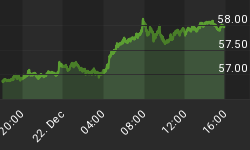Understanding QE
Quantitative Easing (QE) involves pumping freshly printed electronic dollars into the hands of the Fed's primary dealers in exchange for bonds. A bond is removed from the economy and new money is added. If the Fed is on track to reduce/eliminate QE in the coming months, what is their game plan for protecting against a panic-induced spike in interest rates? How will this strategy impact the stock market?

It's Okay - We Plan To Keep Rates Low
Many hold the opinion that QE will never end, since they believe the economy will continue to grow at a tepid pace. As we have argued in the past, tapering is about bubble management, rather than a reaction to economic strength.

Fed mouthpiece, John Hilsenrath, penned the following in Saturday's Wall Street Journal:
One option that has gained support among some Fed officials in recent weeks: Reduce monthly bond purchases by a small amount, say by $10 billion, to $75 billion a month, and signal as loudly as possible the next step will depend on more evidence the job market is continuing to improve and inflation is moving back toward 2% from its current low levels.
As Dallas Fed head Richard Fisher has noted, QE "can't go on forever". For stock and bond investors, the Fed's current track involves questions of "when" rather than "if" tapering will begin.
Bulls Still Have Some Good Looks
The charts have had a bearish bias in recent weeks. Looking at bullish scenarios allows us to see a broader range of possible outcomes for stocks. One bullish scenario for equities considers a delay in the decision process relative to Syria and the fact that the next Fed statement is still almost two weeks away. This week's video examines numerous pieces of "glass half full" evidence, while noting the markets remain in a fragile and tentative state.
Fed Is Concerned About Interest Rates
Our guess is there have been some sleepless nights for Fed governors in recent months. They already feel 2013 looks too much like 1994, where rising interest rates helped push stock and bond prices down simultaneously. From the Wall Street Journal:
Officials have concluded over several months of market volatility that it matters immensely what signal investors take from their actions. They are deeply concerned that any move to scale back the bond-buying program even by a small amount could be seen wrongly by investors as a broader sign that their easy-money policies are ending, which could push long-term interest rates up even more and undermine the recovery they've been trying to encourage.
A Tough Sell
The Fed's course of action is always well-planned in advance. The clear message since the late May utterance of "tapering" from Chairman Bernanke's lips has been, we plan to taper, but we also plan to keep interest rates low for an extended period.

It is noteworthy Hilsenrath's WSJ piece concludes with the following:
The Fed's post-meeting policy statement and Mr. Bernanke's post-meeting press conference are likely to emphasize that short-term interest rates will remain near zero until the jobless rate falls much further and that future reductions in bond purchases aren't set in stone.
Even after Friday's labor report, the script remains "tapering is coming, but also with a strong pledge to keep interest rates low."
Investment Implications
The financial markets remain indecisive and confused. The confusion could be seen in Friday's volatile trading session. The S&P 500 closed 10 points off the intraday high and 14 points off the session low. What did all the intraday volatility produce? No consensus either way; the S&P 500 was basically flat when the closing bell kicked off the weekend.
Our market model did see incremental improvement during the week. Consequently, we increased our exposure to broad market positions (SPY), taking an incremental step back toward risk. We have held small caps and technology (QQQ) through the recent pullback. As shown below, the NASDAQ has held up relatively well from a weekly trend perspective.

Similarly, small caps (IWM) have continued to provide leadership, but momentum has slowed recently.

If the Fed is concerned about the market's reaction to tapering, it seems logical that investors should be concerned as well. Similarly, if the Fed is unsure of how the stock and bond markets will react to news of a punch bowl reduction, it seems logical to adopt a flexible and open-minded stance until some clouds begin to clear. If we pay attention to the market's pricing mechanism, we will never stray too far from a prudent mix between risk and conservative assets.















